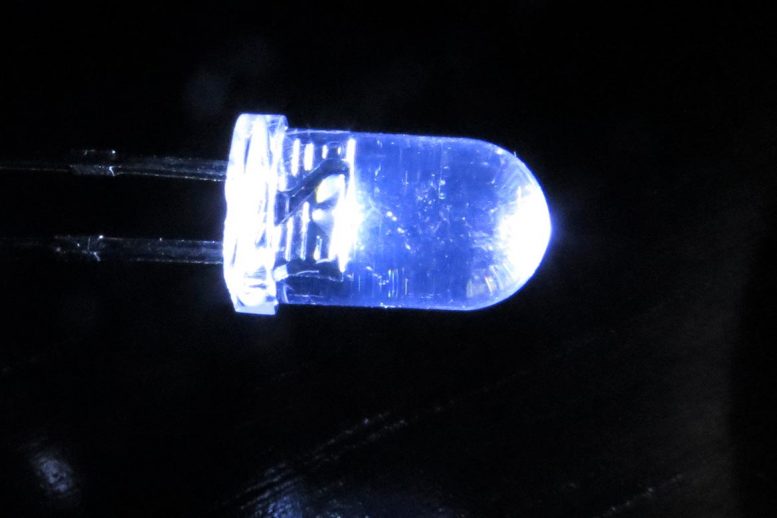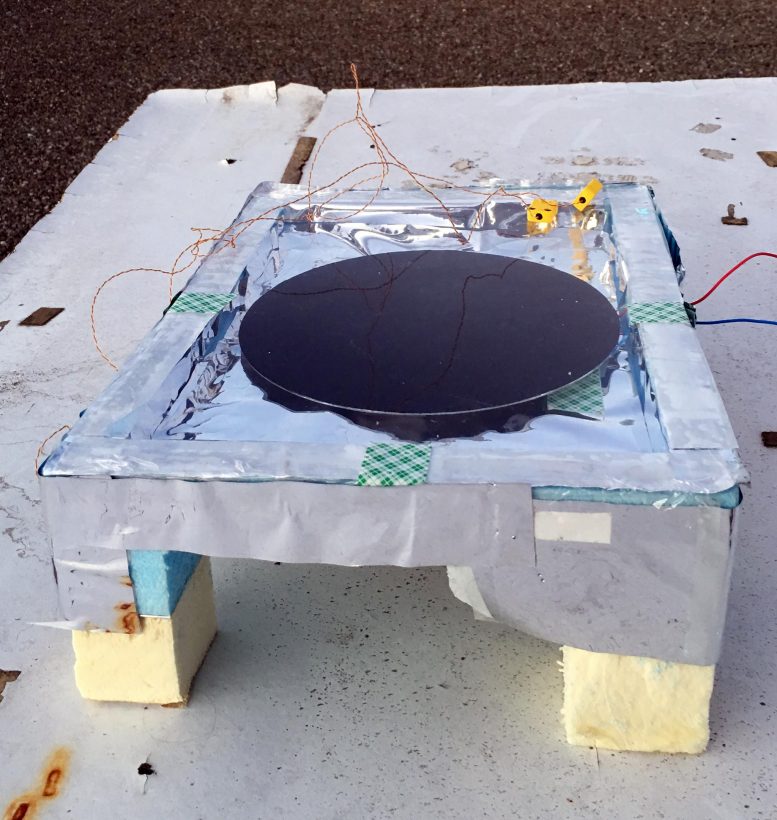
- A thermoelectric generator is built whose cold side radiates heat to the sky
- Night-time power generation of 25 mW/m2 is demonstrated, sufficient for an LED
- Pathways to performance > 0.5 W/m2 using existing commodity components exist
- This approach is immediately practical for lighting and off-grid sensors
When frost forms on the ground overnight even when temperatures are well above freezing, or water droplets appear on car windshields even on a clear night, the cause is often a phenomenon called radiative sky cooling.
In a paper published in the journal Joule, researchers led by a University of California, Los Angeles (UCLA) materials scientist report that they have leveraged the principles behind radiative sky cooling to develop an innovative way to produce renewable energy at night.
The approach could be adapted into a low-cost technology that could eventually be a boon for the more than 1 billion people around the world who, according to the International Energy Agency, lack reliable access to electricity. The concept could be used as a standalone technology or work in combination with solar energy to produce electricity throughout the day and night.
Radiative sky cooling is a natural phenomenon in which a surface that faces the sky ejects its heat into the air as thermal radiation. Some of that heat eventually rises to the upper atmosphere and then into colder reaches of space.
“This effect occurs naturally all the time, especially on clear nights,” said Aaswath Raman, an assistant professor of materials science and engineering at the UCLA Samueli School of Engineering who led the study. “The result is that the object ejecting the heat, whether it’s a car, the ground, or a building, will be slightly cooler than the ambient temperature.”
The new technology takes advantage of that difference in temperatures by capturing some of the heat from the surrounding air that would otherwise rise into the sky and converting it into electricity.

The researchers developed a simple and inexpensive device to demonstrate the technology: All of the parts used in the experiment were purchased at hardware and electronic supply stores for a total cost of less than $30.
Their setup, arranged on the roof of a building, included an aluminum disk that was painted black on one side, which faced the sky. The researchers used the disk to radiate the heat being given off by the surrounding air. A thermoelectric generator — a device that produces electric voltage in response to a temperature difference — then converted that heat into electricity.
The device generated up to 25 milliwatts per square meter, enough to power a single LED light bulb. Although the device generates substantially less energy than a similarly sized solar cell, Raman said it could be used to generate power at night, in locations that are off of the electrical grid or for users who don’t have easy access to batteries.
Raman said the technology could be improved with better components, and that it could potentially generate as much as 0.5 watts per square meter — about 20 times more than the device the researchers demonstrated — especially in hot, dry climates where the radiative cooling effect is the strongest.
With that output, he said, a small setup on the roof of a home could provide enough power overnight to charge a cell phone or to light a room with LED bulbs.
“We think this is an intriguing demonstration of how the cold of space can be accessed as a renewable energy resource and result in modest yet usable amounts of electricity,” Raman said. “We think it also could form the basis of a complementary technology to solar energy. While the power output will always be substantially lower than that of solar devices, this new technology can operate at hours when solar cells cannot.”
The study’s other authors are Wei Li, a postdoctoral scholar, and Shanhui Fan, a professor of electrical engineering, both at Stanford.
Radiative sky cooling has emerged as an active research topic over the past decade. In a study published in Nature in 2014, Raman, Fan and colleagues demonstrated how the phenomenon could be used to cool objects, such as a building, on warm, sunny days. That study was an important step toward using harnessing the phenomenon for energy applications.
Read Device Generates Energy From the Night Sky for more about this invention.
References:
- “Generating Light from Darkness” by Aaswath P. Raman, Wei Li and Shanhui Fan, 12 September 2019, Joule.
DOI: 10.1016/j.joule.2019.08.009 - Reference: “Passive radiative cooling below ambient air temperature under direct sunlight” by Aaswath P. Raman, Marc Abou Anoma, Linxiao Zhu, Eden Rephaeli and Shanhui Fan, 26 November 2014, Nature.
DOI: 10.1038/nature13883
The study was supported by the U.S. Department of Energy.
Never miss a breakthrough: Join the SciTechDaily newsletter.
2 Comments
Excellent article and a pretty interesting phenomenon. It is wonderful that there are scientists thinking on ways of helping poor countries of the world in their energy needs. The way I understood the operation of this setup is that the black surface on the disk absorbs any energy or heat emitted into the air around it and the clear surface under it radiates it to the thermoelectric generator below it to produce electricity. I hope I have it right. Great idea!
ewrtduygihjohugyftdrsea I have to do a debat about this 🙁 I am crying and half-dead rn.